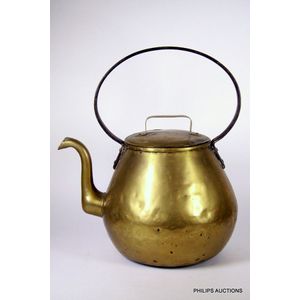Victorian Walnut Serpentine Credenza with Glazed Doors
A Victorian walnut credenza, serpentine form, three glazed doors, carved corbels and raised on plinth base. 12 cm x 39 cm x 84 cm.
You must be a subscriber, and be logged in to view price and dealer details.
Subscribe Now to view actual auction price for this item
When you subscribe, you have the option of setting the currency in which to display prices to $Au, $US, $NZ or Stg.
This item has been sold, and the description, image and price are for reference purposes only.
- Corbel - An architectural term for a support for a projecting bracket, ostensibly supporting a beam or horizontal feature, but used in bookcases, sideboards and chests as a decorative element. Corbels are often carved with acanthus or other scrolling decoration.
- Serpentine - Resembling a serpent, in the form of an elongated 'S'. A serpentine front is similar to a bow front, except that the curve is shallow at each end, swelling towards the middle. The term presumably derives from its similarity to a moving snake or serpent. Serpentine fronts are usually veneered, with the carcase either being cut and shaped from a solid piece of timber, or built in the 'brick' method.
- Plinth - The square or rectangular base of a piece of cabinet furniture, often ornamented with moulding. The plinth may be separate, as in some wardrobes or presses, and act as the support for the carcase. In a false plinth, the moulded boards may be attached directly to the piece. Furniture with a plinth base usually does not have separate feet. The term derives from architecture where it denotes the base of a column or statue.
- Victorian Period - The Victorian period of furniture and decorative arts design covers the reign of Queen Victoria from 1837 to 1901. There was not one dominant style of furniture in the Victorian period. Designers used and modified many historical styles such as Gothic, Tudor, Elizabethan, English Rococo, Neoclassical and others, although use of some styles, such as English Rococo and Gothic tended to dominate the furniture manufacture of the period.
The Victorian period was preceded by the Regency and William IV periods, and followed by the Edwardian period, named for Edward VII (1841 ? 1910) who was King of the United Kingdom and the British Dominions and Emperor of India for the brief period from 1901 until his death in 1910.
This item has been included into following indexes:
Visually similar items

Bass dogs head Guinness match striker, Reed Bros London, 10.5 cm (minor paint Flake)
Sold by
in
for
You can display prices in $Au, $US, $NZ or Stg.

A large antique brass kettle, 19th century, of generous proportions, the bulbous tapering pot with a strap handle to the lid and a large wrought iron hanging handle, height 26 cm
Sold by
in
for
You can display prices in $Au, $US, $NZ or Stg.

Minton 'Travellers Tale' figurine height 18 cm approx
Sold by
in
for
You can display prices in $Au, $US, $NZ or Stg.

Sterling silver vesta, hallmarked Birmingham 1912
Sold by
in
for
You can display prices in $Au, $US, $NZ or Stg.
